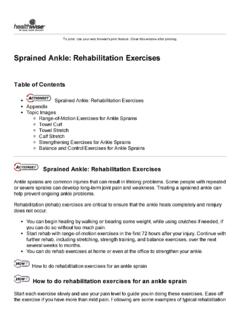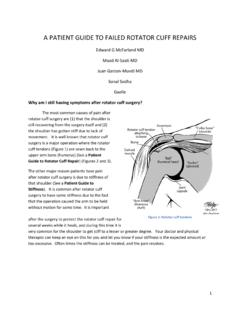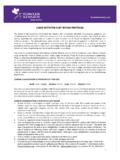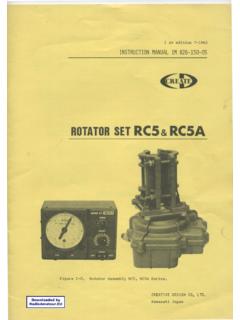Transcription of Rotator Cuff Problems: Exercises You Can Do at …
1 To print: Use your web browser's print feature. Close this window after cuff Problems: Exercises You Can Do at HomeTable of Contents Rotator cuff Problems: Exercises You Can Do at HomeAppendixTopic ImagesShoulderPendulum-Swing exercise for the ShoulderOverhead Stretch for the ShouldersPosterior Stretching exercise for the ShoulderUp-the-Back Stretch for the ShoulderShoulder exercise : Wall Climbing to the SideShoulder exercise : Wall-Climbing to the FrontArm Raise to the SideExternal Rotator Strengthening ExerciseInternal Rotator Strengthening ExerciseShoulder Flexor and Extensor ExercisesScapular exercise : Arm ReachScapular exercise : Wall Push-UpsScapular exercise : Retraction Rotator cuff Problems: Exercises You Can Do at HomeExercises are a very important part of treatment for a Rotator cuff disorder.
2 If pain, weakness, andstiffness in your shoulder (See figure in appendix) are related to problems with your Rotator cuff , adoctor will usually first recommend nonsurgical treatment. Exercises , combined with periods ofrest, ice, and heat and taking nonsteroidal anti-inflammatory drugs (NSAIDs), resolve most rotatorcuff problems. If the pain in or function of your shoulder does not improve with these methods,surgery or other treatment may be need to avoid certain motions and everyday activities that make your problems worse, such asreaching into the backseat of your car or stretches that pull your arms toward your back.
3 Be carefulwhen you begin your Exercises . Slow down or stop the activity if also play a role when your Rotator cuff is treated surgically. You will work with your doctorand physical therapist to plan an exercise program that helps you regain as much strength andflexibility in your shoulder as possible. How do I exercise for Rotator cuff disorders? How do I exercise for Rotator cuff disorders?Before you start these Exercises , talk with your doctor or physical therapist. It is important to beconsistent and do the Exercises as stop exercising and call your health professional if you are not sure you are doing themcorrectly or if you have any pain.
4 Any discomfort you feel during exercise should not last more than2 hours after you finish. And pain should not wake you up at and popping during exercise are not necessarily cause for concern. But a grindingsensation may point to another your shoulder is sore after you exercise , ice exercisesIf you have had surgery to repair a Rotator cuff tear, you will not usually begin any active exercisesuntil at least 3 to 6 weeks after surgery. Active exercise might be allowed right away after surgeryfor tendinitis. Be sure to follow your surgeon's advice on when exactly these Exercises areappropriate.
5 Also, most people wear an immobilizing sling or shoulder brace after surgery. You willneed to ask your doctor about getting help taking it off before you exercise and replacing it at theend of the session. A friend, family member, or physical therapist may be able to help you if yourdoctor should master the stretching Exercises and be able to put your shoulder through its full range ofmotion before you begin strengthening routines. Do the stretching Exercises 5 to 10 times a list below links to specific stretching Exercises with pictures and instructions.
6 The pendulumswing (See figure in appendix) is a good exercise to start stretch (See figure in appendix)Posterior stretching (See figure in appendix)Up-the-back stretch (See figure in appendix)Wall climbing to the side (See figure in appendix)Wall climbing to the front (See figure in appendix)Strengthening exercisesStart strengthening Exercises only after you have your doctor's approval. Usually these exercisesare started gradually as soon as you can do the stretching routine without pain. But these and othersimilar Exercises usually should not be done until at least 6 to 8 weeks after any strengthening Exercises where your arms start at or stretch from your sides, the motionshould be on a diagonal about 30 degrees to the front of where your arms would make a T whenraised 90 degrees to the list below links to specific strengthening Exercises with pictures and raises to the side (See figure in appendix)External Rotator (See figure in appendix)Internal Rotator (See figure in appendix)
7 Shoulder flexor and extensor (See figure in appendix)Scapular strengthening exercisesThe shoulder blade (scapula) is one of the main bones of the shoulder joint. It stabilizes theshoulder from the back side. If the scapula doesn't move well, it puts a lot of pressure on the rotatorcuff and related muscles, which can cause strain. Also, if the scapula is not moving properly, thereis an increased risk of impingement in the subacromial Exercises can help you keep or improve strength around the shoulder blade to help withrotator cuff list below links to specific scapular strengthening Exercises with pictures and protraction with arm reach (See figure in appendix)Scapula protraction with wall push-ups (See figure in appendix)Scapula retraction (See figure in appendix)Credits for Rotator cuff Problems: Exercises You Can Do at HomeByHealthwise StaffWilliam H.
8 Blahd, Jr., MD, FACEP - Emergency MedicineTimothy Bhattacharyya, MDLast RevisedOctober 7, 2013 AppendixTopic ImagesFigureShoulderThe shoulder is made up of three bones: the scapula (shoulder blade), the humerus(upper arm bone), and the clavicle (collarbone). Muscles, tendons, and ligamentshold it together. The outer end of the collarbone is connected to the end (acromion)of the shoulder blade. The bursa is a fluid-filled sac that cushions and lubricates theshoulder area. The Rotator cuff is the group of tendons and their related musclesthat help keep the upper arm bone seated in the socket of the shoulder exercise for the ShoulderIf you have pain in your back, do not do this holding onto a table or the back of a chair with your good arm, bendforward a little and let your injured arm hang straight exercise does not use the arm muscles.
9 Rather, use your legs and yourhips to create movement that makes your arm swing the momentum from your hips and legs, guide the slightly swinging armback and forth like a pendulum (or elephant trunk), then in circles that startsmall (about the size of a dinner plate) and gradually grow larger each day aspain this exercise for 5 minutes, 5 to 7 times each day even while yourshoulder is still tender from an injury or you have less pain, try bending over a little farther to do this exercise . Thiswill increase the amount of movement at your Stretch for the ShouldersStanding about an arm's length away, grasp on to a solid surface, such as acountertop, a doorknob, or the back of a sturdy your knees slightly bent, bend forward with your arms straight, loweringyour upper body and letting your shoulders your shoulders are able to stretch farther, you may need to take a step ortwo for at least 15 to 30 seconds then stand up and relax.
10 If you had steppedback during your stretch, step forward so you can keep your hands on thesolid 2 to 4 Stretching exercise for the ShoulderHold the elbow of your injured arm with your opposite your hand to pull your injured arm gently up and across your body. Youwill feel a gentle stretch across the back of your injured for at least 15 to 30 seconds, then slowly lower your 2 to 4 Stretch for the ShoulderYour doctor or physical therapist may advise you to wait to do this stretch until youhave regained most of your range of motion and strength.












